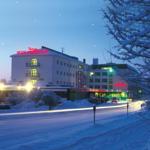The chart for the municipality of Rovaniemi was made in 1785 and it received city rights on 1.1.1960.
At the beginning of 1939, there were about 6 500 inhabitants in Rovaniemi. The same year the WW II started. The war destroyed Rovaniemi almost completely, but a new Rovaniemi rose out from the burnt ruins. In 1946, the great rebuilding based on the architecture of Alvar Aalto got underway.
The antler-like layout of Rovaniemi, which is easier to distinguish from the air or from a map, as well as its major buildings, the City Hall, the library and the Lappia House are all the result of the architectural creativity of Aalto. Read more about the architecture of Alvar Aalto in my post.
Rovaniemi has always been the stopping place for those travelling north of coming south. Its widely renowned fair (Rovaniemen Markkinat) has attracted people from far and wide every year since 1880s.
In 1920s the tourism was born here with the building of the legendary Hotel Pohjanhovi, souvenir shops, view points and finally, the start of the development at the Arctic Circle.
The history of the city entered a new era at the turn of 2005-2006 when the City of Rovaniemi and the Rural Municipality of Rovaniemi, that was surrounding the city, merged into one. The new city formed from these two, has a population of more than 60 000 people today.
With a surface area of 8016 km2, it is the 15th largest city in Europe, although much of its surface is covered by forest.
The Rovaniemi Coat of Arms (Rovaniemen vaakuna) is made by the artist Toivo Vuorela in 1956. It is a silver pall on a green background and a golden flame top centre. The pall signifies the meeting of the rivers Kemijoki and Ounasjoki. The two branches are staggered like lightning bolts like symbols of the water power plants up in these rivers. The golden flame signifies a signal of fire that was often lit on riverside hilltops when the region was placed under threat of oppressors. This is how the artist Toivo Vuorela describes the Rovaniemi Coat of Arms.




